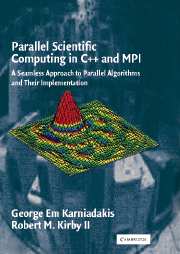 Parallel Scientific Computing in C++ and MPI
Parallel Scientific Computing in C++ and MPI Published online by Cambridge University Press: 05 October 2013
We have already discussed how to solve tridiagonal linear systems of equations using direct solvers (the Thomas algorithm) in Chapter 6 and some iterative solvers (Jacobi, Gauss-Seidel, SOR, and multigrid) in Chapter 7. We have also discussed solutions of nonlinear and linear systems and have introduced the conjugate gradient method in Chapter 4. In the current chapter we revisit this subject and present general algorithms for the direct and iterative solution of large linear systems. We start with the classical Gaussian elimination (which is a fast solver) and then proceed with more sophisticated solvers and preconditioners for symmetric and nonsymmetric systems.
In parallel computing, we introduce the broadcasting command MPI_Bcast and demonstrate its usefulness in the context of Gaussian elimination. In addition, we reiterate the use of MPI_Send, MPI_Recv, MPI_Allgather, and MPI_Allreduce through example implementations of algorithms presented in this chapter.
GAUSSIAN ELIMINATION
Gaussian elimination is one of the most effective ways to solve the linear system
Ax = b.
The Thomas algorithm (see Section 6.1.4) is a special case of Gaussian elimination for tridiagonal systems.
To save this book to your Kindle, first ensure [email protected] is added to your Approved Personal Document E-mail List under your Personal Document Settings on the Manage Your Content and Devices page of your Amazon account. Then enter the ‘name’ part of your Kindle email address below. Find out more about saving to your Kindle.
Note you can select to save to either the @free.kindle.com or @kindle.com variations. ‘@free.kindle.com’ emails are free but can only be saved to your device when it is connected to wi-fi. ‘@kindle.com’ emails can be delivered even when you are not connected to wi-fi, but note that service fees apply.
Find out more about the Kindle Personal Document Service.
To save content items to your account, please confirm that you agree to abide by our usage policies. If this is the first time you use this feature, you will be asked to authorise Cambridge Core to connect with your account. Find out more about saving content to Dropbox.
To save content items to your account, please confirm that you agree to abide by our usage policies. If this is the first time you use this feature, you will be asked to authorise Cambridge Core to connect with your account. Find out more about saving content to Google Drive.